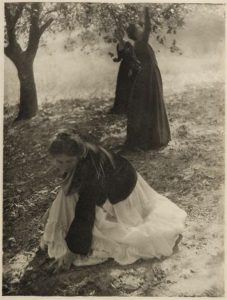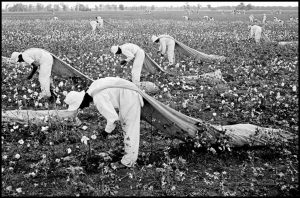
![]() A member of the circle of pictorialist photographers championed by Alfred Stieglitz in the pages of the magazine Camera Work, Clarence White was an important voice for photography as fine art. Working in the medium of platinum prints, often reproduced as photogravures, White frequently portrayed his family and friends performing simple actions.
A member of the circle of pictorialist photographers championed by Alfred Stieglitz in the pages of the magazine Camera Work, Clarence White was an important voice for photography as fine art. Working in the medium of platinum prints, often reproduced as photogravures, White frequently portrayed his family and friends performing simple actions.
The Orchard shows three women picking apples. Instead of focusing on the hard work of the harvest season, White posed his fashionably dressed figures in the act of picking fruit from the trees or ground. A high viewpoint allows us to look down on the flowing skirt of the foreground figure, while the mid-ground women are silhouetted artistically in their dark dresses.

White’s decision to emphasize the artistic components of this scene runs counter to his political beliefs. As a Socialist, White believed in workers’ rights and the injustice of poverty; however, his politics rarely informed his photography.[footnote]Maynard White, Jr., “Clarence H. White: Artist in Life and Photography,” in Clarence H. White (Wilmington: Delaware Art Museum, 1977), 19. [/footnote] Instead, he steadfastly stayed “on the art side of things,” as his student, Dorothea Lange, later recalled.[footnote]Maynard White, Jr., “Clarence H. White: Artist in Life and Photography,” in Clarence H. White (Wilmington: Delaware Art Museum, 1977), 23.[/footnote] Compared to Danny Lyon’s photograph of Texas penitentiary prisoners forced to harvest cotton, White’s image idealizes agricultural labor in the interest of aesthetic appeal.